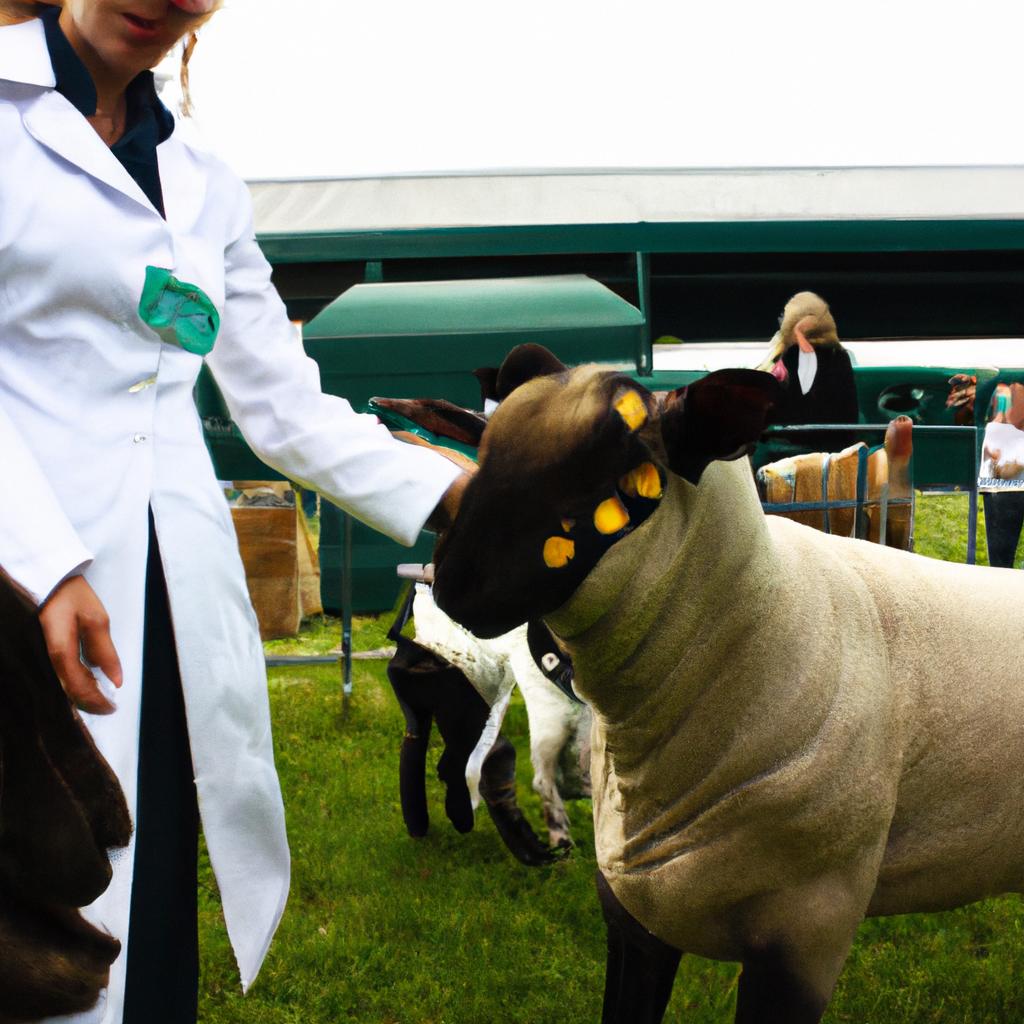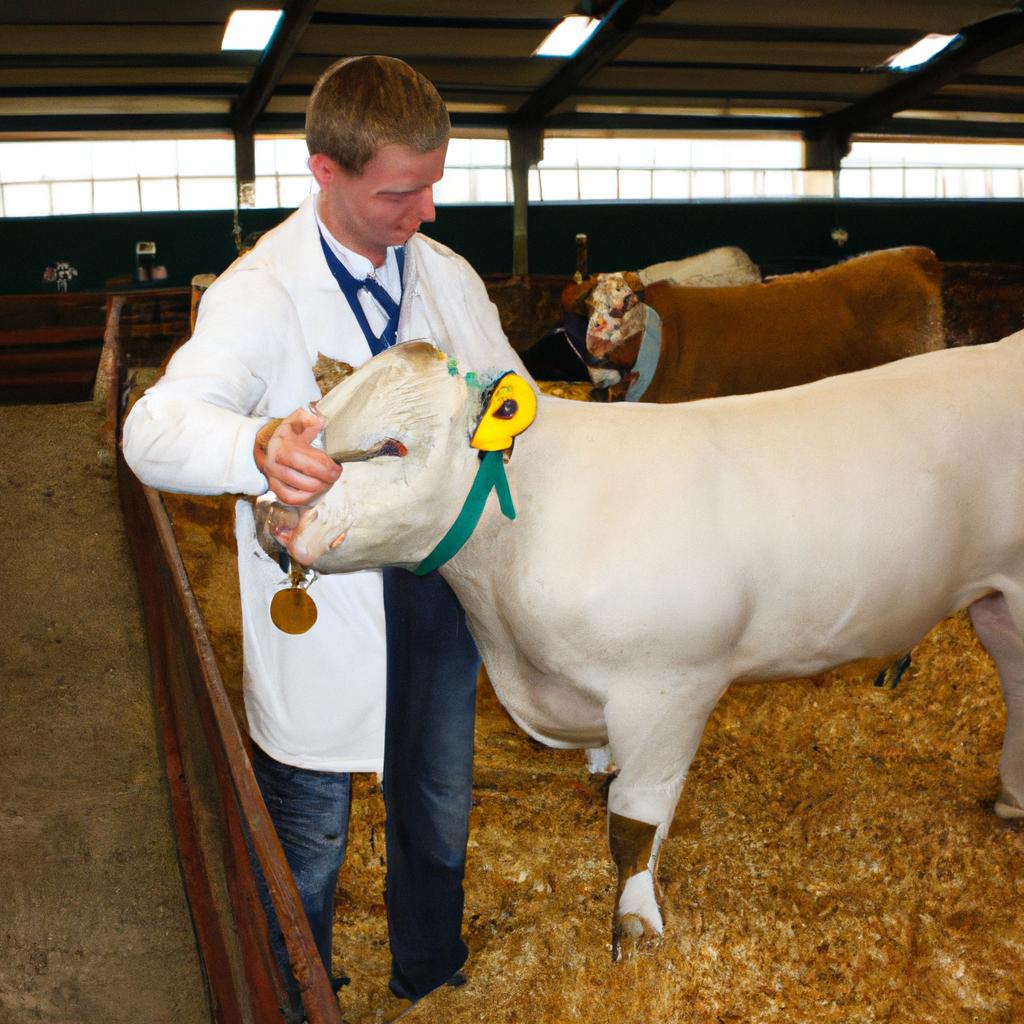Livestock exhibitions have long been an integral part of county fairs, showcasing the hard work and dedication of farmers and breeders. These events serve as a platform for participants to display their animals while competing for prestigious prizes in various categories. The Five County Fair Livestock Exhibitions is one such event that offers a diverse range of prize categories, recognizing excellence in areas such as breeding, showmanship, and overall animal health.
To illustrate the significance of these prize categories, let us consider the case of John Miller, a local farmer who has been participating in the Five County Fair Livestock Exhibitions for over a decade. With his prized Holstein cows, he regularly competes in the dairy cattle category and strives to secure the top spot each year. By meticulously caring for his animals’ nutrition, grooming, and veterinary needs throughout the year, Miller aims not only to win first place but also to showcase exemplary breeding practices.
The assortment of prize categories at the Five County Fair Livestock Exhibitions allows individuals like John Miller to demonstrate their expertise and passion within specific domains of livestock farming. In addition to recognizing excellence in traditional aspects such as conformation and performance characteristics, these categories also highlight other crucial elements essential to successful livestock rearing. Show Showmanship, for instance, evaluates the handler’s ability to present and control their animal in a professional and skillful manner. This category emphasizes the importance of effective communication between the exhibitor and their animal, showcasing the bond and trust developed through consistent training and handling techniques.
Another significant prize category is overall animal health, which recognizes farmers who prioritize the well-being and welfare of their livestock. This includes proper nutrition, vaccination schedules, regular veterinary care, and maintaining clean and comfortable living conditions for the animals. Exhibitors who excel in this category demonstrate their commitment to ensuring optimal health and happiness for their animals throughout the year.
Furthermore, breeding categories assess participants’ skills in selecting superior genetics to improve desired traits in their livestock. This involves careful consideration of factors such as conformation, productivity, temperament, and disease resistance when choosing parent stock for breeding purposes. By excelling in these categories, breeders like John Miller showcase their dedication to advancing the quality of livestock within their specific breed or species.
Overall, these diverse prize categories at livestock exhibitions serve not only as a platform for competition but also as an avenue for education and inspiration within the agricultural community. They encourage participants to continually strive for excellence while highlighting different aspects of successful livestock rearing that are crucial to sustainable farming practices.
Category 1: Cattle
Livestock exhibitions at the Five County Fair offer a diverse range of categories, each showcasing the exceptional qualities and characteristics of various animals. In this section, we will explore the first category: cattle. To illustrate the significance of this category, let’s consider an example involving a prize-winning Holstein cow named Daisy.
Cattle enthusiasts from across the region gather to witness the beauty and prowess of these magnificent creatures. Within the cattle category, participants compete in several subcategories such as dairy cattle and beef cattle. The judging criteria encompass elements such as conformation, breed standards, and overall presentation.
To evoke enthusiasm among both participants and spectators alike, here is a bullet point list highlighting some notable aspects of the cattle exhibition:
- Impeccable grooming techniques that accentuate each animal’s features
- Impressive display of strength during showmanship competitions
- Meticulously maintained health records, ensuring optimal well-being for all animals
- Opportunities for young farmers to develop valuable skills through participation
Moreover, it is worth mentioning that livestock exhibitions are not only about competition but also serve as platforms for education and community engagement. As shown in Table 1 below, various activities accompany the cattle exhibition to enrich attendees’ experience:
| Activities | Description | Purpose |
|---|---|---|
| Educational Seminars | Informative sessions on topics like breeding and nutrition | Enhancing knowledge |
| Livestock Auction | Sale of top-quality animals | Supporting local farmers |
| Youth Competitions | Events tailored specifically for younger participants | Encouraging youth involvement |
| Animal Showcase | Displaying different breeds with informational placards | Promoting awareness and appreciation for diversity |
With its vibrant atmosphere and emphasis on excellence in husbandry practices, the cattle exhibition sets an inspiring tone for other livestock categories. As we move forward into the next section on “Category 2: Swine,” we continue our exploration of the captivating world of Five County Fair’s livestock exhibitions.
Category 2: Swine
Prize Categories: Five County Fair Livestock Exhibitions
In the realm of swine exhibitions at the Five County Fair, participants compete to showcase their finest specimens. One such exhibitor, John Thompson, entered his prized Yorkshire pig named Bella into last year’s competition. Bella stood out amongst the other contestants due to her exceptional size and a beautifully proportioned frame.
To fully understand the criteria used to assess swine entries in this category, it is important to consider several key factors that judges take into account:
-
Weight and Growth Rate:
- Judges evaluate pigs based on their weight at exhibition time.
- Pigs with rapid growth rates are seen as desirable because they demonstrate potential for increased meat production.
-
Conformation and Structure:
- The overall structure of the pig is assessed, including its bone structure and musculature.
- An ideal pig should have well-developed ham muscles and a straight top line.
-
Body Condition:
- A healthy layer of fat covering the muscle without being excessively fatty or thin is considered optimal.
- Exhibitors strive for pigs that display proper body condition score (BCS).
-
Presentation:
- Exhibitors must present their swine in flawless condition by grooming them meticulously before showcasing them at the fair.
- Attention is paid to cleanliness and overall appearance.
Judges use these criteria when evaluating each entry in the swine category at the Five County Fair livestock exhibitions. They assign points accordingly based on how well an animal meets these standards.
Table: Characteristics Considered in Swine Judging
| Criteria | Description |
|---|---|
| Weight | Assessing pigs’ weight at exhibition time |
| Growth Rate | Evaluating pigs’ rate of growth |
| Conformation | Examining bone structure and musculature |
| Body Condition | Determining the healthiness of fat layers and muscle density |
| Presentation | Assessing cleanliness and overall appearance |
As we delve into the next section, Category 3: Poultry, it is important to recognize the diverse nature of livestock competitions at the Five County Fair. Each category presents its own unique challenges and requirements, making for an engaging and captivating event that draws both participants and spectators alike.
Category 3: Poultry
Prize Categories: Five County Fair Livestock Exhibitions
In the previous section, we explored Category 2: Swine in the Five County Fair Livestock Exhibitions. Now, let’s move on to Category 3: Poultry, which showcases various types of domesticated birds such as chickens, ducks, and turkeys.
To illustrate the significance of this category, consider a hypothetical case in which a young farmer named Sarah decides to participate in the poultry exhibition. She meticulously raises her flock of heritage breed chickens with utmost care, ensuring they are well-fed and housed comfortably. Sarah spends hours every day observing their behavior and health signs to ensure optimal conditions for each bird.
The importance of poultry exhibitions extends beyond personal achievement for participants like Sarah. Here are some key reasons why these events generate great enthusiasm among both exhibitors and fairgoers:
- Education: Poultry exhibitions provide an opportunity for people to learn about different breeds of domestic fowl and understand their characteristics.
- Competitiveness: The competitive aspect fosters perseverance and dedication among exhibitors striving for recognition through prize-winning birds.
- Community Engagement: These exhibitions serve as social gatherings where farmers can exchange knowledge, discuss best practices, and establish connections within the agricultural community.
- Economic Impact: The popularity of poultry exhibitions attracts numerous visitors who contribute to local economies by spending on food concessions, souvenirs, rides, and other fair attractions.
Emotions associated with poultry competitions range from excitement to anticipation. For instance:
| Emotion | Reason |
|---|---|
| Joy | Winning a prestigious prize after months of hard work |
| Pride | Showcasing one’s exceptional breeding skills |
| Curiosity | Exploring diverse breeds up close |
| Admiration | Witnessing extraordinary talent and expertise |
In summary, Category 3: Poultry in the Five County Fair Livestock Exhibitions is a captivating showcase of domesticated birds. Participants like Sarah invest considerable time and effort to raise their flock, while fairgoers enjoy learning about different breeds and experiencing the competitive atmosphere. The emotional reactions elicited from participants and visitors alike contribute to the vibrant energy surrounding these exhibitions.
Moving forward, let’s delve into Category 4: Sheep, where we will explore another fascinating aspect of the Five County Fair Livestock Exhibitions.
Category 4: Sheep
Prize Categories: Five County Fair Livestock Exhibitions
Continuing the exploration of livestock exhibitions at the Five County Fair, this section delves into Category 4: Sheep. To illustrate the significance of this category, let us consider a hypothetical scenario where a shepherd named John participates in the fair with his prized herd of sheep.
Sheep are highly valued for their wool and meat production, making them an integral part of agricultural practices worldwide. In Category 4, exhibitors showcase various breeds of sheep, highlighting their distinct characteristics such as size, coloration, and fleece quality. For instance, John enters his flock of Dorset Horn sheep renowned for their exceptional fertility and ability to adapt to different climates.
The importance of Category 4 becomes evident when we examine its prize categories:
- Grand Champion Ram
- Grand Champion Ewe
- Reserve Champion Ram
- Reserve Champion Ewe
These awards recognize outstanding individuals within each sex category based on criteria like conformation, muscling, body structure, and overall health. The anticipation builds up as participants compete for these prestigious titles that not only bring recognition but also enhance breeding opportunities and future market value.
To provide a visual representation of the notable prizes awarded in Category 4: Sheep at the Five County Fair, here is a summary table showcasing previous winners:
| Year | Grand Champion Ram | Grand Champion Ewe |
|---|---|---|
| 2018 | Suffolk – “Rambo” | Rambouillet – “Lily” |
| 2019 | Hampshire – “Rocky” | Border Leicester – “Bella” |
| 2020 | Shropshire – “Charlie” | Southdown – “Daisy” |
| 2021 | Texel – “Maximus” | Romney – “Sophie” |
This table demonstrates the diversity and quality of sheep breeds exhibited at the fair, captivating both participants and spectators alike. Witnessing these majestic animals compete for recognition adds an element of excitement to the event.
In preparation for our next exploration into Category 5: Goats, we can appreciate how Category 4: Sheep showcases the beauty and functionality of this remarkable livestock species. The Five County Fair provides a platform for breeders like John to display their expertise in maintaining superior genetic lines while contributing to the advancement of sheep farming practices.
Moving forward, let us now turn our attention towards Category 5: Goats, where a myriad of goat breeds awaits us with their unique characteristics and contributions to agriculture.
Category 5: Goats
Moving on from the previous section on sheep, we now delve into Category 5: Goats in the Five County Fair Livestock Exhibitions. These exhibitions showcase the finest breeds of goats and offer various prizes to recognize excellence in different aspects of goat rearing.
For instance, let us consider a hypothetical case study of a farmer named John who participates in the Goat category at the fair. John raises Boer goats, a breed known for their meat production. He enters his prized Boer buck, Hercules, into the competition with hopes of securing top honors.
To better understand the prize categories within this category, below is a list that highlights some key areas judges assess when evaluating goats:
- Conformation: Judges closely examine each goat’s body structure and overall appearance to determine its fitness and adherence to breed standards.
- Milk Production: This category focuses on assessing dairy goat breeds based on their milk yield and quality.
- Fiber Quality: This criterion primarily applies to Angora and Cashmere goats, examining their fiber’s softness, length, fineness, and other relevant qualities.
- Showmanship: In this performance-based category, participants are evaluated based on how well they present their goat while showcasing its best features.
The following table provides an overview of some potential prize categories for goats at the Five County Fair Livestock Exhibitions:
| Prize Category | Criteria | Prize Amount |
|---|---|---|
| Best in Show | Overall excellence | $500 |
| Grand Champion | Highest scoring individual across all criteria | $300 |
| Reserve | Second-highest scoring individual | $200 |
| Breed-specific | Recognition specific to each breed | Varies |
In conclusion to our discussion of Category 5: Goats at the Five County Fair Livestock Exhibitions, it is evident that participating farmers like John have ample opportunities to showcase their goats and potentially win prestigious prizes. As we now turn our attention to Category 6: Rabbits, let us explore the unique qualities that make these furry creatures a popular choice among livestock enthusiasts.
Category 6: Rabbits
Moving on from the captivating world of goats, we now delve into the enchanting realm of rabbits. These cuddly creatures have long been admired for their soft fur and adorable appearance. Rabbit exhibitions at the Five County Fair Livestock Exhibitions are a sight to behold, showcasing various breeds and sizes of these lovable animals.
To understand the significance of rabbit exhibitions, let’s consider an example. Imagine a family attending the fair with their young children. As they explore the livestock area, their eyes widen in awe as they come across rows upon rows of cages housing rabbits in all shapes and colors. The children can’t contain their excitement as they eagerly point out their favorite bunnies while parents enjoy witnessing their sheer joy and fascination.
The importance of rabbit exhibitions extends beyond mere entertainment value; it serves several significant purposes:
- Education: Exhibiting rabbits allows visitors to learn about different breeds and characteristics, enhancing their knowledge about these furry friends.
- Breeding Improvement: By showcasing high-quality rabbits, breeders inspire others to improve breeding standards, leading to better overall quality within rabbit populations.
- Networking: Rabbit exhibitors have opportunities to connect with fellow enthusiasts, fostering a supportive community that shares information and expertise.
- Promotion: Exhibitions offer businesses specializing in rabbit-related products or services an avenue to showcase their offerings directly to targeted audiences.
As attendees walk through the exhibition space filled with cages lined up row after row like small homes for these fluffy companions, emotions run high:
- Excitement fills the air as families discover new rabbit breeds they never knew existed.
- A sense of compassion arises when visitors witness how well-cared-for each bunny is by its dedicated owner.
- Curiosity piques as people stop by informational booths where experts share tips on proper rabbit care.
- Warmth spreads throughout as volunteers guide children gently petting rabbits under careful supervision.
In this delightful setting, visitors can also refer to the following table, which displays key information about different rabbit breeds exhibited at the fair:
| Breed | Origin | Coat Type |
|---|---|---|
| Holland Lop | Netherlands | Short and dense |
| Flemish Giant | Belgium | Dense but soft |
| Netherland Dwarf | England | Medium-length with a thick undercoat |
| Lionhead | Belgium/England | Long, wool-like mane around head |
The combination of engaging interactions with rabbits and access to valuable information leaves attendees uplifted. They depart from the exhibition area not only entertained but also armed with new knowledge about rabbit breeds, responsible ownership, and potential connections within the supportive community.
Through these captivating livestock exhibitions, the Five County Fair continues to provide an enriching experience that entertains, educates, and fosters a sense of camaraderie among enthusiasts of all ages. So come join us in celebrating these adorable creatures as we move on to explore further categories in this journey through the fair!
 Five County Fair
Five County Fair



